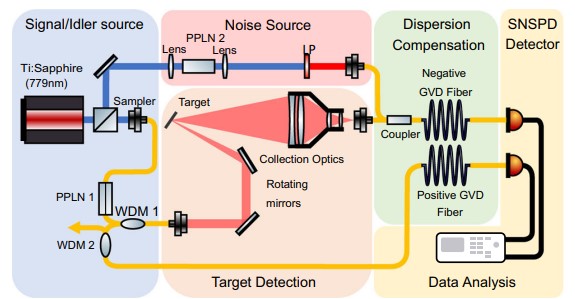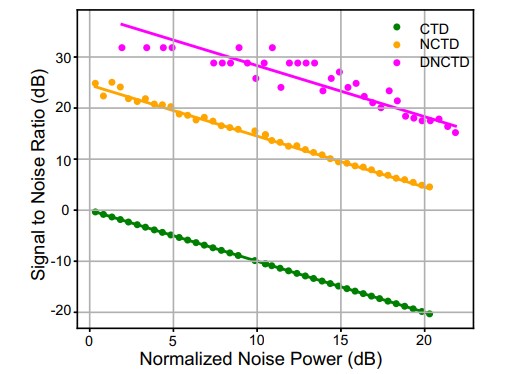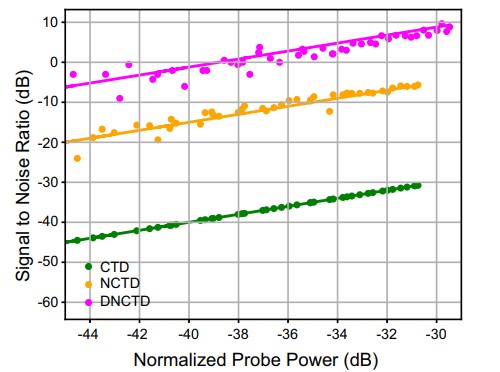Nonlinear Quantum Optics
Quantum-inspired LiDAR
Quantum illumination (QI) is a technique that utilizes entangled probe light to interrogate a target, and joint detection measurements with a reference light to determine the presence or absence of the target. But its practical applications are limited due to fundamental power constraints. This limitation hinders QI's ability to meet the demands of real-world sensing applications that require high probe power for extended detection ranges. To address the limitations of QI, chaotic-quantum frequency conversion (QFC) LiDAR based on coherent measurement of classical time-frequency correlation is introduced.

Experimental setup of the chaotic-QFC LiDAR system

The spectrum of reference light (dashed red), probe light without SFG (solid red), probe
light with SFG (magenta), and SFG light (blue)
Both experimental and theoretical studies are performed in this design. Experimental result shows that the coherent sum-frequency generation (c-SFG) efficiency can reach up to 90% with around 260mW input reference power, in agreement with Monte Carlo simulation. While the theoretical modeling provides insights into the performance characteristics of chaotic-QFC LiDAR, demonstrating its potential for significantly enhancing LiDAR sensitivity while addressing practical challenges such as noise rejection and signal processing.

The theoretically predicted (curve) and
experimentally measured efficiency

The homodyne signal level for different probe and noise power
Moreover, this chaotic technique can be applied in quantum information applications to provide performance enhancement compared to pulse-based quantum frequency conversion. Its advantages of high efficiency and selectivity can be useful for high-dimensional quantum information processing applications such as Boson sampling.
χ2-based phase sensitive amplifier
Phase sensitive amplifiers (PSAs) are gaining attention for their ability to mitigate noise limitations in amplification. They also offer advantages such as optical phase and amplitude regeneration, dispersion compensation, and improved imaging and sensing performance. Traditionally, PSAs have primarily relied on third-order nonlinearities (χ3) which involves four-wave mixing (FWM) for their operation. However, second-order nonlinearities (χ2) are stronger but have been less utilized in semiconductor-based PSAs due to challenges in effectively phase matching the interacting waves and countering two-photon absorption of the pump. Although, this second-order nonlinear (χ2) approach provides numerous benefits such as immunity to stimulated Brillouin scattering, larger nonlinear coefficient, better pump filtering, low noise, low cross talk, and no intrinsic frequency chirp.

Experimental setup

PSA in-phase gain measured as a function of external pump power
These benefits can be achieved by employing an efficient phase matching approach and utilizing a pulsed pump in an AlGaAs Bragg reflection waveguide. It demonstrates impressive on-chip in-phase gain of nearly 30 dB and a sensitivity of 0.005 photons per pulse. Additionally, its performance approaches the theoretical minimal noise figure of 0 dB. Importantly, the PSA operates in the single-mode regime, holds promise for the advancement of on-chip quantum circuits.

PSA gain measured as a function of wavelength

The noise figure (NF) as a function of amplifier gain
In conclusion, this development represents a significant step forward in leveraging second-order nonlinearities for semiconductor-based PSAs, with potential applications in both classical and quantum on-chip signal processing, as well as optical communication systems.
Quantum and non-local effects towards quantum lidar
Light Detection and Ranging (LiDAR) systems often struggle with noise, which can degrade the accuracy and reliability of the generated maps. However, Quantum-enhanced LiDAR systems hold promise for overcoming these limitations. By exploiting quantum phenomena such as entanglement and quantum superposition, these techniques can provide higher resolution, better sensitivity, and improved noise resilience compared to classical imaging method.

Experimental setup

Optics for LiDAR demonstration
Experimental measurement demonstrated that these quantum effects provide quantum lidar systems with a noise resilience advantage of over 40dB, making them highly promising for applications requiring precise measurements in noisy environments. However, the quantum-enhanced LiDAR system based on time-frequency entanglement demonstrates a remarkable 43dB higher signal-to-noise ratio (SNR) compared to a classical phase-insensitive quantum imaging system. This higher SNR indicates that the quantum-enhanced system can provide clearer and more accurate imaging results, even in noisy environments.

Signal-to-noise ratio for varying noise power

Signal-to-noise ratio for varying probe power
Hence, these advancements pave the way for the widespread adoption of quantum-enhanced imaging technologies in various applications, including non-reflecting target imaging in noisy environments.